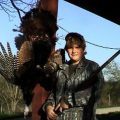I want to clean up a bunch of questions that have been asked of me. Some have been recent; others go back a ways. Mostly, this is about ambushing, but there’s more.
You keep talking about ambushing being good and stalking being bad. Why is that?
Let me explain some things the way I see it, and maybe you will understand. This question is probably in reference to a piece I wrote a while back where I stated that hens go to gobblers and not the other way around, I meant this in a general sort of way. This is one of the basic dynamics that make turkey hunting what it is; a hunter is attempting to reverse the roles and convince the gobbler to come to him. Granted, some days this can be easier than others. However, I stand by my statement that the main reason a gobbler will hole up at a particular place all season and never come to a call is simply that he does not have to. The hens are coming to him.
On the Subject of Stalking
Now let me address stalking. Stalking in relation to turkey hunting is a bad idea. It is even been considered illegal in some states. I looked for a definition of stalking, but there really was not any out there, so I guess I am going to have to wing it. I’ll begin by giving you an example. It is early in the morning, you blow your owl call and a gobbler answers– not too close, but not all that far away. What do you do?
- Start a slow, deliberate silent pursuit, being careful not to break twigs. Keep a mouth call in so that you can continue to make contact with the gobbler as needed. Close the distance until you can see him, but he can’t see you.
- Find the nearest tree that is at least as wide as your shoulders and sit your butt down and start calling to the gob.
- Use your experience in the woods to find the most advantageous position to call to the gobbler, then use Option #2.
Option #1 is stalking. It is not a good idea for two major reasons:
- Turkeys are some of the best-prepared game species for detecting threats coming toward them. They have phenomenally good hearing and eyesight. Putting your stalking skills against a gobbler’s ability to detect you will nearly always result in failure.
- Historically, this is how a lot of hunters died, being mistaken for game. Before Hunter Education began, guys went into the woods trying to stalk gobblers down. Another turkey hunter, hunting the same gobbler would see movement and. . . Let me point you to something that I used to tout every year. You’ll see why this can be such a dangerous thing: Treerooster’s Tale– The Annual Safety Post
On the Subject of Ambushing:
I think the general reason folks here and elsewhere tiptoe on the subject of ambushing is that there are a strongly opinionated bunch of turkey hunters out there that will pounce at the mention of ambush. I remember an article written about hunting Kentucky in the early season several years ago. At the time, there was a battle royal raging on the T&TH Forum over the subject of ambush, and I remember the author being coincidentally very careful in how he described the latter part of his hunt. The first few days had been ideal, but had not produced turkeys, so the party resorted to “other methods.” Those methods involved careful use of woodsmanship and lots of patience. In short: ambushing the birds. It happens. In Kentucky, there are a lot of days that gobblers will not come to calls right off the roost. Some say tomato, Some say ambush.
Me? Look, I had to throw out everything I knew about turkey hunting and take a fresh look at things before I could be successful on a fairly regular basis at my farm in the Trans-Bluegrass. One of the chief things I had to cut out of my repertoire was the idea of roaming the property every day like it was a fresh start. It was not. On 200 acres, the birds roost on pretty much the same trees, and flop down and move in pretty much the same ways every day, and season to season. I kept finding myself with my back against pretty much the same set of trees on a regular basis. Do I call? Yes, every day. Do I think calling is the biggest factor? No. Patience and woodsmanship. Allow me to confess.
What few hunters will appreciate is the idea of sitting in the same spot for a month and seeing what it does, or testing the idea of using the same few calls all-season versus changing up every day versus every few days. What I have found, experimenting with all these things is that:
- If you find the right spot, you can sit all season and take gobblers all the way from beginning to end. You can have hens pick at your shoelaces. However, you cannot do this and be a demonstrably aggressive caller. You cannot do this wearing a white T-Shirt that shows at the collar, or a having shiny gun barrel that gets waved around. You cannot do this unless you are resigned to being primarily an observer and not an actor.
- You can use the same 3 calls all the way through season as long as you are sparing with them. Going out and throwing the kitchen sink at the same turkeys will not get your tags filled anymore.
- If you are willing to just sit and listen at flydown, turkeys will more often than not come back around mid-morning. When they do, the same gobbler that would not give you the time of day at sunrise will sometimes walk over to you and beg you to shoot.
- If you sit your butt against the same tree and stay there all season, you will visited by mostly silence and walk home most days feeling defeated. Sprinkled in those crushing failures will be moments of extreme excitement and sometimes even success. I have had both tags filled by the first Wednesday of season. I have hunted all season and never gotten a shot.
- If you are looking for the one tactic I have found that produces the most turkeys from the same spot. If you can make your calls sound like a hen that does not hear, or is interested in something else, you can bring a gobbler in more consistently than sounding interested and attentive. When we learn to call, we think of carrying on a conversation with the gobbler. The opposite can have the best results. Gobblers are used to not being heard; their natural response is to get closer to the hen.
Other Terms worth Mentioning
When you hear about stalking vs. ambushing, you will hear several other terms mentioned.
Pussy-footing: Look, there is no line judge or umpire out there throwing flags. Pussy-footing is trying to walk so nothing can hear you. How is that not stalking? If you’re trying to get into an advantageous spot to call in a gobbler, that is pussy footing. That’s okay. If you’re trying to close on the gobbler so you can see him and get a shot, that’s stalking.
End-Around: This is a tactic our subs used to great success in WWII They would sight a Japanese convoy at great distance and then run on the surface out and around the convoy, get ahead of the convoy and then sit and wait, low in the water until the Convoy got within firing range. Substitute a shotgun for the torpedoes and put the gobbler in the role of the Japs and you get the idea. How is this not stalking? If you move away from the gobbler and run around him, you’re not trying to close on him. You want him to close on you.
Woodsmanship: A lot of this boils down to a simple statement: “If I do it, it’s expert woodsmanship. If you do it, it must be illegal, unethical, and morally wrong.” There is a lot of this sort of hooey in the sport. I freely admit. I’ve belly crawled on a gobbler. Was that stalking? I dunno. I’ve hid in a barn on Tuesday after seeing hens dusting and a gobbler strutting there on Monday. Was that ambushing? I’ve gotten up from my blind and closed about half the distance to a gobbler to entice him in the rest of the way. Was that stalking? You make up your mind:
PODCAST: The shaman scores in KY Opener 2012
Views: 4









